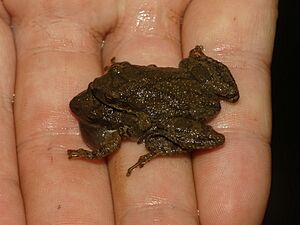Appalachian mountain chorus frog facts for kids
Quick facts for kids Appalachian mountain chorus frog |
|
|---|---|
 |
|
| Conservation status | |
| Scientific classification | |
| Synonyms | |
|
The Appalachian mountain chorus frog (Pseudacris brachyphona) is a small type of frog. It used to be called just the mountain chorus frog. This frog lives only in the United States. You can find it in forests, near rivers, in swamps, and around ponds. It also lives in ditches and canals.
Sadly, this frog is facing a threat. Its natural habitat (the place where it lives) is shrinking. This means it has fewer safe places to call home.
Contents
About This Frog
What's in a Name?
The Appalachian mountain chorus frog got its new name in 2020. Before that, another frog, the Collinses' mountain chorus frog, was thought to be the same species. But scientists found out they were different! The Collinses' frog lives in places like North Carolina, Tennessee, Alabama, and Mississippi. Because of this discovery, the original frog was renamed to highlight its home in the Appalachian mountains.
Tree Frogs: The Acrobats of the Amphibian World
The Appalachian mountain chorus frog belongs to the family called Hylidae. This family is also known as the tree frogs. Tree frogs are a very large group within the order called Salientia (or Anura). This order includes all frogs and toads.
Tree frogs are known for being colorful and very good at climbing. They are sometimes called the "clowns and high-wire artists" of the amphibian world. There are almost 500 different kinds of tree frogs. You can find them all over the world, from warm tropical areas to the cooler woods of Canada and Australia.
How to Spot One
Size and Color
The Appalachian mountain chorus frog is a small frog. It is about average size for frogs in its group, the Pseudacris genus. These frogs come in different shades of grey or brown. Some are sorghum brown, deep brownish-drab, or mars brown.
Body Shape
This frog has a stocky body. This means it looks quite solid and strong. Its head is also wider than its body. This shape is similar to the pine woods tree frog.
Measurements
Adult Appalachian mountain chorus frogs grow to be about 1.0 to 1.4 inches (25 to 36 mm) long. Male frogs are usually between 24 and 32 mm (0.9 to 1.3 inches). Female frogs are a bit larger, measuring between 27 and 34 mm (1.1 to 1.3 inches).
Special Features
You can often spot this frog by a triangle shape between its eyes. It also has a white line along its upper lip. Male frogs have a dark throat.
Where They Live
Geographic Home
The Appalachian mountain chorus frog lives in several parts of the United States. You can usually find them in southwestern Pennsylvania, western Maryland, southeastern Ohio, eastern Kentucky, West Virginia, eastern Tennessee, and northern Alabama. In Alabama, they live north of the Tennessee River.
Preferred Places
These frogs like to live on hillsides. They can be found in grassy pools and ditches. They often live away from big bodies of water. The wooded hillsides where they make their homes can be quite high up. They live at elevations up to 3,500 feet (1,067 m).
What They Sound Like
A Unique Call
The Appalachian mountain chorus frog has a very special call. It is a fast, high-pitched sound. The call has a clear quality and form. The sounds repeat quickly, and the pitch is high. It sounds a bit like the call of the Pacific chorus frog. However, the Appalachian frog's call is less clearly made of two syllables.
Listening to a Chorus
When many of these frogs call together, it's called a chorus. You can tell their chorus apart from other frog groups. The Appalachian mountain chorus frog's call repeats 50 to 70 times every minute. They can keep calling for several minutes, but usually stop after 15 to 20 seconds.
How Far It Travels
This distinct call is very rapid. On a clear night, you can hear it up to a quarter-mile away! Their voice sounds a bit nasal. Some people say it sounds like a wagon wheel turning that needs oil. It is a harsh, raspy sound, like "wreeck" or "reek." The Collinses' mountain chorus frog has a similar call, but its pulse rate is faster.
Frog Families
Breeding Season
The Appalachian mountain chorus frog breeds from February through April. This is when the male and female frogs come together to lay eggs.
Laying Eggs
The female frog lays her eggs in small, shallow pools of water. These pools are usually found in the woods or near waterways in the woods. If the frog lives at the bottom of a hill, it might lay eggs in ditches, pools along streams, or springs.
The eggs are laid in small groups. Each group has about 10 to 50 eggs. These egg groups stick to plants in the water. A female frog can lay about 500 eggs in total.
Tadpole Life
After the eggs hatch, tiny tadpoles emerge. The tadpole stage lasts for about 50 to 56 days. During this time, the tadpoles grow and change. Once the tadpoles reach about 8 mm (0.3 inches) in size, they change into young frogs. This process is called metamorphosis.
What They Eat
Appalachian mountain chorus frogs mostly eat invertebrates. Invertebrates are small creatures without backbones. This includes many types of insects. These frogs do not climb very much. If they do climb, it is usually into weeds to find and catch insects to eat.


